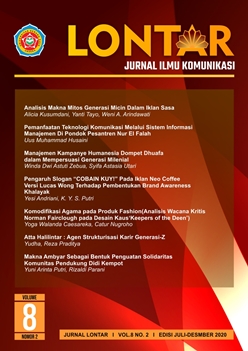Komodifikasi Agama pada Produk Fashion (Analisis Wacana Kritis Norman Fairclough pada Desain Kaus ‘Keepers of the Deen’)
DOI:
https://doi.org/10.30656/lontar.v8i2.2526Abstract
Penelitian ini menggunakan pendekatan Analisis Wacana Kritis model Norman Fairclough, untuk menggambarkan wacana dan ideologi serta praktik-praktik agama yang bersentuhan dengan budaya populer. Objek terfokus pada desain produk-produk kaus Keepers of the Deen, yang mana sangat bermuatan pesan-pesan dakwah, sekaligus mengadopsi gaya-gaya dan bentuk budaya populer. Pada dasarnya, aktivitas kapitalisme pada budaya - budaya populer, merupakan sebuah hal yang tidak bisa dihindarkan; kedua unsur tersebut saling menyatu, mendukung, tumpang-tindih, dalam kehidupan sehari-hari. Selain itu, tak heran juga jika bentuk kapitalisme tersebut semakin berkembang dalam menyambut kemajuan teknologi dan komunikasi, salah satunya yakni komodifikasi, yang kemudian terus merespon dan direspon oleh berbagai gaya hidup masyarakat kontemporer. Kondisi dilematis muncul ketika semua hal tersebut beriringan dengan aktivitas spiritual atau dalam praktik-praktik beragama, salah satunya adalah dakwah, terutama dengan menggunakan sebuah medium atau gaya yang lebih populer, seperti menggunakan kebutuhan sandang atau fashion. Termasuk Keepers of the Deen, pada akhirnya merupakan sebuah bukti bahwa karakteristik dakwah adalah fleksibel dan cair, serta dapat mengikuti kondisi sebuah zaman. Akan tetapi, kondisi tersebut perlu dicermati ulang secara kritis, terlebih jika sudah terjerat dalam “logika kapitalisme†yang merupakan keniscayaan dalam budaya populer serta praktik komodifikasi yang lebih mutakhir.
Downloads
Published
Issue
Section
License
By submitting an article to the journal, the author(s) agree to transfer the published article's copyright to the journal, which will act as the publisher. This means the journal will have the right to publish the article in various forms, including reprints. The journal will maintain the publishing rights to the published articles.
In line with the license, authors and third parties (readers, researchers, and others) are allowed to share and adapt the material. In addition, the material must be given appropriate credit, provided with a link to the license, and indicated if changes were made. If authors remix, transform, or build upon the material, authors must distribute their contributions under the same license as the original.






